Mercedes-Benz C-Class Mk4 is an appealing choice as a used executive saloon, because it covers a lot of bases really well. The comfort levels in particular are very good, which in conjunction with the classy and well-equipped cabin make the Mercedes very cossetting on longer journeys. It’s not all smooth sailing for the C-Class Mk4, though: practicality in particular is an area where the car loses some ground to its alternatives, and the Mercedes doesn’t have the strongest record for reliability, either.
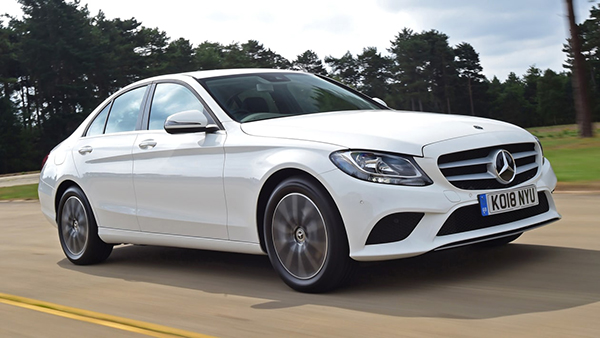
The fourth-generation Mercedes C-Class executive saloon went on sale in the UK in February 2014, with the launch line-up being quite limited. Three trim levels were available – entry-level SE spec, the mid-range Sport grade and the range-topping AMG Line trim level – and the engine line-up initially only comprised a 184hp 2.0-litre four-cylinder petrol called the C200 and a 170hp 2.1-litre four-cylinder diesel that was named C220 BlueTEC.
Over time, the C-Class Mk4 line-up became much more diverse. A 204hp C250 BlueTEC diesel joined the range in September 2014, and by April 2015 there were C300 diesel-electric and C350 petrol-electric hybrid options to choose from. Performance car buyers would be catered for from spring 2015 with the launch of the 476hp C63 AMG flagship model, and a less potent C43 version with 362hp went on sale in April 2016.
It wasn’t just the engine range where the C-Class Mk4 expanded over time. The conventional four-door saloon bodystyle that was available from launch was complemented with a more spacious estate variant in June 2014, and a more stylish but less practical two-door coupe was added to the price lists in October 2015. From February 2016, there was even a two-door C-Class Cabriolet model with a folding fabric roof.
The core Mercedes C-Class Mk4 range would remain as is until May 2018, when the entire C-Class range was given a comprehensive mid-life facelift. While the trio of trim levels were carried over unchanged, a number of engines were replaced with newer like-for-like alternatives, and the exterior and interior were given nip-and-tuck cosmetic tweaks. The facelift also replaced the two previously available hybrids with new C300e petrol and C300de diesel plug-in hybrid powertrains.
In this guise, the Mercedes C-Class Mk4 remained on sale, until it was replaced in July 2021 with the launch of the fifth-generation Mercedes C-Class saloon and estate models.
What are the alternatives?
Two of the biggest thorns in the side of the fourth-gen Mercedes C-Class when new were the Audi A4 and BMW 3 Series executive saloons. Like the Mercedes, the Audi and BMW came with well-appointed interiors and premium-badge appeal, although the C-Class does have the slight edge over that pair of cars when it comes to comfort.
Upmarket alternatives to the C-Class go beyond the offerings from Audi and BMW, too. Credible contenders to the Mercedes that place an emphasis on comfort include the Lexus IS and Volvo S60, and there are also the Alfa Romeo Giulia and Jaguar XE if you’re after a sportier drive.
At the more mainstream end of the spectrum, you also have options such as the Ford Mondeo, Peugeot 508 and VW Passat. These cars won’t match the Mercedes for plushness, but they make up for it by being much more affordable to buy.
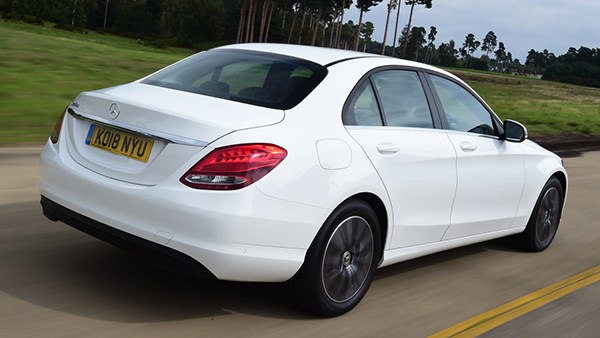
Mercedes C-Class vs BMW 3 Series vs Jaguar XE
In 2019, we pitted the Mercedes C-Class against the Jaguar XE and the BMW 3 Series – the last of these having just gone on sale in the UK at the time. Despite faring well in areas like comfort, equipment levels, the Mercedes wasn’t able to triumph in this three-way head-to-head, though we did rate the C-Class higher overall than the Jaguar XE.
Mercedes C-Class vs Jaguar XE vs Alfa Romeo Giulia
Fresh from a mid-life fresh in 2018, the Mercedes C-Class found itself fighting the Jaguar XE and Alfa Romeo Giulia in our executive car group test. The revisions had done their work, too: the C-Class was the overall winner, with the Mercedes’ better comfort, refinement, practicality and affordability giving it the edge.
The Mercedes C-Class Mk4 will cost a bit more to buy than its non-premium counterparts, although it should be a bit more affordable than its direct rivals due to the car’s lower residual values. Fuel economy is pretty good across the board, but do take note that the Mercedes sits in higher insurance groups than some of its alternatives and can be a bit pricey to service.
Prices
Despite what the prestige of the Mercedes badge on the bonnet may suggest, the C-Class Mk4 doesn’t have the strongest residual values of its peers. Because of that depreciation, the Mercedes should be a lot more affordable to buy now than it was brand new.
If you’re looking for the most cost-effective way into fourth-gen C-Class ownership, you’ll need to consider the less powerful petrol and diesel options, with the latter likely to make up a large chunk of the used listings you’ll find for the Mercedes. Expect to pay a premium for higher-spec cars, with the AMG models being the priciest examples you can buy.
To check out how much your ideal Mercedes C-Class Mk4 will cost, make sure you check out the used listings on our sister site Buyacar.
Fuel economy and emissions
The Mercedes C-Class Mk4 was available with many engine types, and so the fuel economy varies considerably depending on what’s under the bonnet. If you’ll primarily be doing longer drives, the diesels will be the most efficient options. Mercedes claimed the C220d could return up to 55.4mpg, and quoted a slightly worse 51.4mpg figure for the more powerful C300d. Officially, the entry-level C200d was capable of up to 68.9mpg, though that model’s fuel economy wasn’t calculated using the same method as the C220d and C300d.
Other models whose fuel economy figures you shouldn’t take at face value are the plug-in hybrid C300e and C300de versions. These models are claimed to return up to 188mpg and 235mpg respectively, but that is wholly dependent on how often you’re able to drive the car using just the electric motor. However, because both plug-in hybrids have low CO2 emissions of up to 37g/km, they incur the most affordable annual tax rates.
Perhaps unsurprisingly, the petrol engines are the least frugal ones available on the Mercedes C-Class Mk4, though they’re still efficient considering the fuel they use. The C200 model is capable of returning 42.2mpg, and the C300 is a bit worse at 39.8mpg. Unsurprisingly, the AMG models are the least efficient in the C-Class Mk4 range, with Mercedes quoting 29.1mpg and 26.2mpg for the C43 and C63, respectively.
Running costs
The Mercedes C-Class Mk4 doesn’t have strict service intervals, because all cars come with a system that monitors the condition of key components and alerts the driver using dashboard prompts when maintenance work is needed. As a result, no two servicing jobs will be the same. As a rule of thumb, though, Mercedes recommends a check-up once every 24 months or 20,000 miles, whichever comes first. Services alternate between minor and major, and prices will start from around £370.
All of the C-Class Mk4’s engines are chain-driven, so there aren’t any cambelts to replace. The brake fluid does need to be renewed every two years, though, and this job is carried out as part of the service.
The Mercedes C-Class Mk4 will likely be a bit more expensive to insure than some of its main rivals, because it sits in slightly higher insurance groups. The C-Class ranges from insurance group 23 to insurance group 49 – in comparison, the Audi A4 ranges from insurance groups 19 to 44, and the BMW 3 Series’ insurance groups range from 18 to 45.
The Mercedes C-Class Mk4 may not be for you if you’re after the roomiest possible used saloon car, although there is sufficient space inside for taller passengers and their luggage. Safety features across the board are pretty good and, while the more recent post-facelift models do benefit from more up-to-date tech, all models were fitted as standard with a handy amount of equipment.
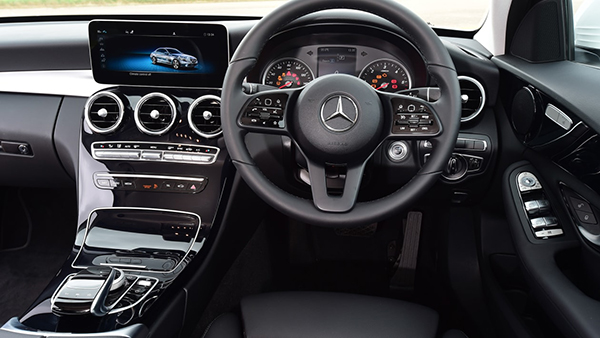
Dimensions, cabin and boot space
Size-wise, the Mercedes C-Class Mk4 is on par with its key rivals. At 4,688mm long, 1,810 wide and 1,442mm tall, the Mercedes takes up a similar amount of space on the road as the generations of Audi A4 it went up against at the time it was on sale.
However, while the exterior dimensions are about the same, that can’t quite be said for the interior of the C-Class. This is especially the case with rear-seat practicality; due to factors including the sloping roofline, there isn’t a huge amount of headroom on offer in the back of the Mercedes when compared with more spacious rivals such as the BMW 3 Series. Still, there is at least a decent amount of legroom. Thankfully, there’s plenty of space for the driver and the front seat passenger.
Boot space is also decent in the C-Class Mk4, if not spectacular by segment standards. At 455 litres, the C-Class’s cargo capacity is better than a Volvo S60’s (442 litres), but down on an Audi A4’s (480 litres). Do also bear in mind the boot capacity can vary, depending on the powertrain of the car you’re looking at. For instance, C200 models with the mild-hybrid petrol engine have a slightly reduced capacity of 435 litres, which falls to 300 litres on the plug-in hybrid C300e and C300de versions due to the way the battery pack is positioned underneath the boot floor.
Equipment and technology
Throughout the car’s lifecycle, the Mercedes C-Class Mk4 was available in three trim levels: SE, Sport and AMG Line. SE was the entry-level trim, and came as standard with a reversing camera, two-zone climate control, automatic windscreen wipers, cruise control and a seven-inch centre console display. When the C-Class was facelifted in 2018, the standard kit list on this trim was expanded to include adjustable suspension and a 10.25-inch screen to replace the original seven-inch item.
Mid-range Sport trim level models came with broadly the same equipment as the SE trim, albeit with a few detail changes such as LED headlights, lowered suspension and more supportive front seats. At the top of the Mercedes C-Class Mk4 pecking order was the AMG Line trim, which injected a bit of AMG performance-car flavour to the regular car thanks to a more aggressive bodykit, firmer sports suspension, new interior features such as a sporty steering wheel and uprated brakes.
An array of features was also available across the Mercedes C-Class Mk4 range as optional extras. The selection of additional equipment was quite exhaustive, too: heated front seats, a head-up display unit, an upgraded sound system, blind spot monitoring and lane-keeping driver assists, an air suspension system, a 12.3-inch digital instrument display and even split-folding rear seats were relegated to the options list.
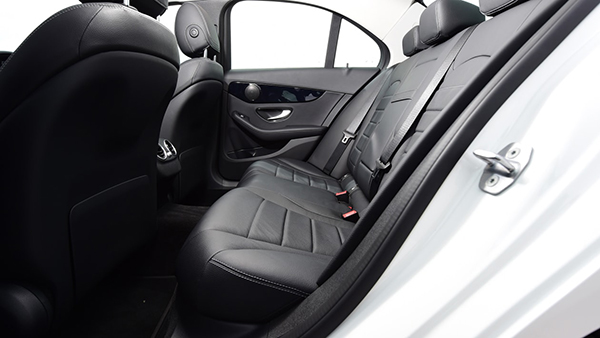
Safety
The Mercedes C-Class Mk4 was awarded a five-star safety rating when it was assessed by Euro NCAP in 2014. It performed especially well in adult occupant protection, with a score of 92 per cent in that category, and the C-Class still did well in the child protection (84 per cent), pedestrian protection (77 per cent) and safety tech (70 per cent) categories.
As standard, the Mercedes C-Class was fitted with a good amount of safety equipment. All cars came with seven airbags, a tyre pressure-monitoring system, a driver-attention monitor and an emergency braking-assist system that can automatically apply the car’s brakes if an imminent collision is detected. Optional safety equipment included a head-up display unit and blindspot monitoring.
The Mercedes C-Class is a car that focuses more on comfort and handling, and is more suited to life on long motorway cruises than on a twisty road. While there are more sporting and fun to drive alternatives out there, the C-Class Mk4 is still a decent-enough steer, and the high-performance AMG models in particular are great fun.
Engines and performance
Finding the ideal engine for you in a used Mercedes C-Class Mk4 shouldn’t be too difficult, as the car was available with a broad array of options when new. These ranged from more modestly powered petrols and diesels to a pair of punchy engines reserved for the high-performance AMG models and even a selection of plug-in hybrid offerings.
Many of the used C-Class Mk4 examples you’ll come across will likely have diesel engines. The entry-level C200d models are decent options, although the C220d is a more flexible choice if you need a bit more performance or regularly do a bit of towing. If you need more performance still, there were even punchier C250d and C300d diesel options to choose from.
It’s a similar story on the petrol engine front. C180 cars have enough punch if you mostly drive around towns and cities, but performance is more adequate on the mildly more powerful C200 option. If you need more performance still, there was also a punchy C300 engine, though this is more expensive to run.
Do bear in mind that, even on models sold throughout the C-Class Mk4’s production run, the engine line-up did change. While the C180d diesel used the same 1.6-litre engine, the 2.1-litre four-cylinder that was used on all other pre-facelift diesel models was replaced with a more refined 2.0-litre four-cylinder as part of the facelift in 2018. For the petrol engines, the C200’s original 2.0-litre four-cylinder was replaced in the facelift with a 1.5-litre four-cylinder, with the rest of the range (bar the 3.0-litre six-cylinder C43 and 4.0-litre V8 C63 AMG models) using variations of a 2.0-litre four-cylinder.
Also be wary that the gearbox choices changed during the facelifts, too. Originally, the C-Class Mk4 was available with either a six-speed manual or a seven-speed automatic, with many of the engines being automatic-only. After the 2018 facelift, the manual gearbox was dropped entirely and the seven-speed automatic was replaced with a nine-speed automatic gearbox.
Over the course of the C-Class Mk4’s lifecycle, a pair of plug-in hybrid engines were also available, in the form of the 320hp C300e petrol-electric and 306hp C300de diesel-electric setups. On paper, they promise great efficiency (Mercedes claims the C300e and C300de can return up to 188mpg and 235mpg respectively), but how close you’ll get to that in day-to-day driving will depend on how often you can make use of their electric-only ranges of up to 35 miles. They were also very expensive when new, so aren’t as common as petrol and diesel C-Class Mk4s in the classifieds.
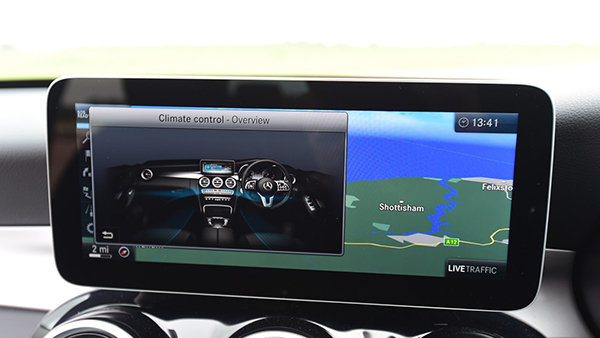
On the road
The Mercedes C-Class Mk4 is a car that focuses more on comfort than driving thrills, which means it’s worth considering if you do lots of long journeys. Regardless of whether the car’s using the regular suspension or the optional air suspension system, the C-Class has a pleasantly pliant ride, which in conjunction with the good noise insulation makes the Mercedes a well-rounded motorway cruiser.
Because of that focus on comfort, the C-Class Mk4 isn’t as precise or as fun to drive as some other executive saloons, such as the BMW 3 Series and Jaguar XE. That said, the car does feel fairly agile relative to its size thanks to the direct steering. However, unless you go for one of the high-performance AMG models, the front tyres do start to lose grip a bit sooner than we’d like when you’re going around corners.
For a majority of Mercedes C-Class models, the car came as standard with rear-wheel drive. If you need a bit more traction for towing duties or extra peace of mind when driving in slippery conditions, an optional all-wheel-drive setup was available on the C200 petrol and C220d and C300d diesel models. Both the C43 and C63 AMG versions of the Mercedes C-Class were only available with all-wheel drive.
In its final year being featured as a car available to buy new, the Mercedes C-Class Mk4 wasn’t exactly a standard-setter in our 2021 Driver Power survey. The C-Class was ranked 71st out of 75 cars, and owners said they weren’t impressed with the build quality or reliability. Keep a look out for the issues below when you’re looking around used examples.
Common used Mercedes-Class Mk4 problems
Brakes
The brakes on the Mercedes C-Class Mk4 can squeal, in particular the ones on the front wheels, and this can be difficult to rectify.
Wind noise
Poorly fitting doors and seals can result in an excessive amount of wind noise entering the cabin.
Audio
Many Mercedes C-Class Mk4 owners say the standard-fit stereo isn’t punchy enough. Even the upgraded sound system has suffered from this issue.
Trim
The artificial leather MB-Tex seat upholstery can discolour and appear stained.
Recalls
The Mercedes C-Class Mk4 has suffered 20 recalls to date, covering a variety of faults and defects. These include a leaking AdBlue filler pipe on diesel models, loss of power assistance for the steering, oil and fuel leaks and the engines running the risk of stalling. Other issues the fourth-gen Mercedes C-Class has been recalled for include seatbelts failing to function properly and airbags failing to go off in the event of an accident, and a loss of control when driving due to the steering column working free.
For some owners, the Mercedes C-Class Mk4 has been a bit of a mixed bag. While this generation of C-Class has made its way on to the list of top 75 cars on quite a few occasions, reliability has frequently been cited as one of the worst aspects of the car.
Reliability
Based on our Driver Power customer satisfaction surveys, the Mercedes C-Class Mk4 doesn’t have the strongest of reliability records: in the 2021 survey, the car was ranked 71st out of the eligible 75 cars, with owners citing mechanical durability as one of the car’s weakest areas. The Mercedes brand itself fared a bit better, with a mid-table ranking of 13th out of 29 manufacturers putting it ahead of Audi and BMW, but behind Lexus, Volvo, Jaguar and Tesla.
Mercedes-Benz C-Class W205 Full Review
11/11/2021
No Comments
Mercedes-Benz | Mercedes-AMG
Click to rate this post
[Total: 1 Average: 5]